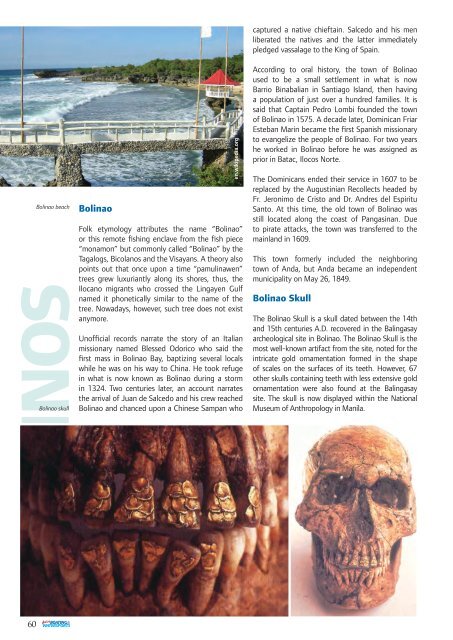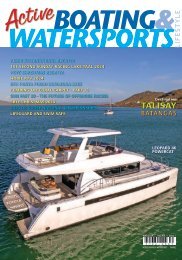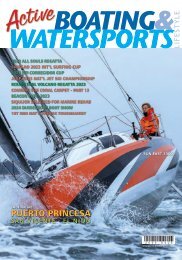ABW June 2017
You also want an ePaper? Increase the reach of your titles
YUMPU automatically turns print PDFs into web optimized ePapers that Google loves.
ALAMINOS<br />
60<br />
Bolinao beach<br />
Bolinao skull<br />
Bolinao<br />
en.wikipedia.org<br />
Folk etymology attributes the name “Bolinao”<br />
or this remote fishing enclave from the fish piece<br />
“monamon” but commonly called “Bolinao” by the<br />
Tagalogs, Bicolanos and the Visayans. A theory also<br />
points out that once upon a time “pamulinawen”<br />
trees grew luxuriantly along its shores, thus, the<br />
Ilocano migrants who crossed the Lingayen Gulf<br />
named it phonetically similar to the name of the<br />
tree. Nowadays, however, such tree does not exist<br />
anymore.<br />
Unofficial records narrate the story of an Italian<br />
missionary named Blessed Odorico who said the<br />
first mass in Bolinao Bay, baptizing several locals<br />
while he was on his way to China. He took refuge<br />
in what is now known as Bolinao during a storm<br />
in 1324. Two centuries later, an account narrates<br />
the arrival of Juan de Salcedo and his crew reached<br />
Bolinao and chanced upon a Chinese Sampan who<br />
captured a native chieftain. Salcedo and his men<br />
liberated the natives and the latter immediately<br />
pledged vassalage to the King of Spain.<br />
According to oral history, the town of Bolinao<br />
used to be a small settlement in what is now<br />
Barrio Binabalian in Santiago Island, then having<br />
a population of just over a hundred families. It is<br />
said that Captain Pedro Lombi founded the town<br />
of Bolinao in 1575. A decade later, Dominican Friar<br />
Esteban Marin became the first Spanish missionary<br />
to evangelize the people of Bolinao. For two years<br />
he worked in Bolinao before he was assigned as<br />
prior in Batac, Ilocos Norte.<br />
The Dominicans ended their service in 1607 to be<br />
replaced by the Augustinian Recollects headed by<br />
Fr. Jeronimo de Cristo and Dr. Andres del Espiritu<br />
Santo. At this time, the old town of Bolinao was<br />
still located along the coast of Pangasinan. Due<br />
to pirate attacks, the town was transferred to the<br />
mainland in 1609.<br />
This town formerly included the neighboring<br />
town of Anda, but Anda became an independent<br />
municipality on May 26, 1849.<br />
Bolinao Skull<br />
The Bolinao Skull is a skull dated between the 14th<br />
and 15th centuries A.D. recovered in the Balingasay<br />
archeological site in Bolinao. The Bolinao Skull is the<br />
most well-known artifact from the site, noted for the<br />
intricate gold ornamentation formed in the shape<br />
of scales on the surfaces of its teeth. However, 67<br />
other skulls containing teeth with less extensive gold<br />
ornamentation were also found at the Balingasay<br />
site. The skull is now displayed within the National<br />
Museum of Anthropology in Manila.


















